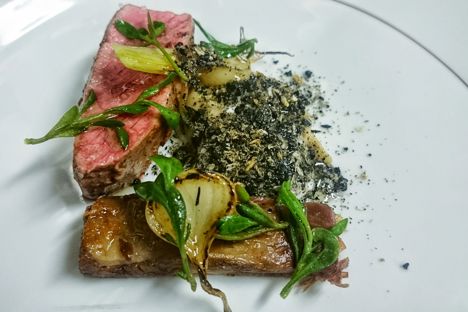Ash has been used one way or another in cooking for many hundreds of years. In South America, meat and fish are cooked in large pits of smouldering ashes over long periods of time, giving mouth wateringly smoky results. Native Indians would add ash to the water when cooking corn as it was believed to make the husks easier to remove, which in recent times it has been proven to have beneficial effects on health due to the calcium and potassium present in the ash.
In more recent times, ash has had a bit of a renaissance in modern cooking, being thrust into the limelight by Michelin-starred restaurants such as Noma in Copenhagen and Mugaritz in Spain. Noma features root vegetables such as celeriac which are rubbed with hay ash before being baked in a salt-crust pastry. At Mugaritz, they make ash from vegetables such as leek and horseradish.
The most commonly found use for ash is in cheese-making; this is an old process which was originally used to preserve the cheese as the alkaline ash neutralises the acidic surface of the cheese allowing for protective moulds to grow on the surface. The ash also soaks up moisture from the cheese preventing the mould from growing too rapidly.
How to make ash
The easiest way to make ash is to simply set light to hay in a steel bucket and let it burn until only the ashes remain. This should then be stirred up and kept in sealed containers to avoid moisture.
It is also possible to make ash from alliums such as leeks, onions and spring onions by cooking for a long time at a low temperature until dried and blackened and then ground to a powder.
How to cook with ash
To make ash-baked vegetables, simply peel the vegetable of your choice and rub the ash in. Celeriac and turnip both work well. The vegetable can then be wrapped in either foil or a salt crust pastry and baked in the oven.
Ash can also be sprinkled on to finished dishes to give a striking and smoky garnish to a plate.
What ash goes with
Ash is predominantly used to give a bitter, smoky flavour to food. It is best used in small quantities as it can easily overpower more subtle foods. Ash goes particularly well with strong flavours such as red meat, onions and cheese. Pascal Aussignac uses a juniper ash in his recipe for cod with butternut squash and licorice sabayon, while Alan Murchison uses ashed goat’s cheese and serves it with roasted beetroot and a black olive tuile.
Get in touch
Please sign in or register to send a comment to Great British Chefs.



